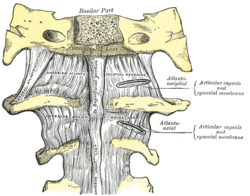| Atlanto-occipital joint | |
|---|---|
 Anterior atlanto-occipital membrane and atlantoaxial ligament. | |
 Posterior atlanto-occipital membrane and atlantoaxial ligament. | |
| Details | |
| System | Skeletal |
| Identifiers | |
| Latin | articulatio atlantooccipitalis |
| MeSH | D001269 |
| TA98 | A03.1.08.001 |
| TA2 | 1630 |
| FMA | 24939 |
| Anatomical terminology | |
The atlanto-occipital joint (Articulatio atlantooccipitalis) is an articulation between the atlas bone and the occipital bone. It consists of a pair of condyloid joints. It is a synovial joint.
